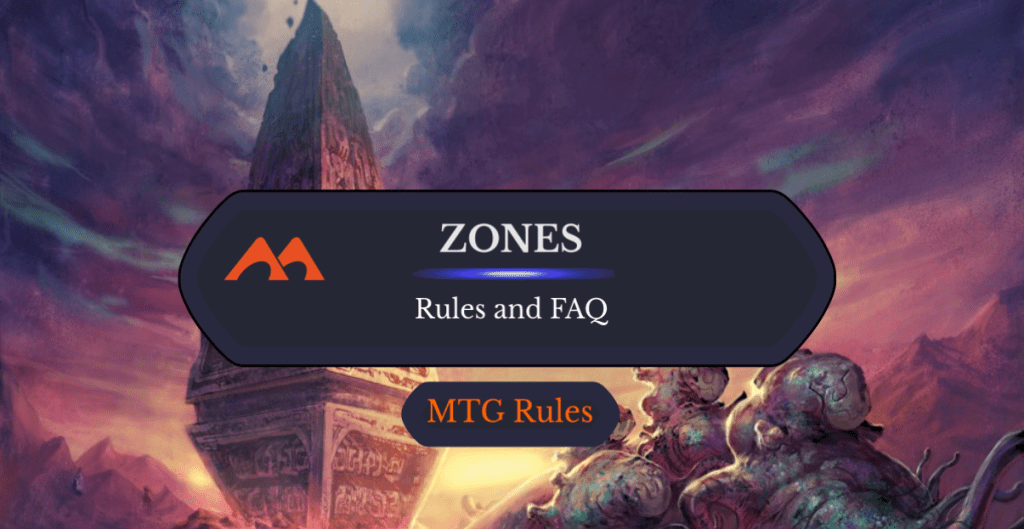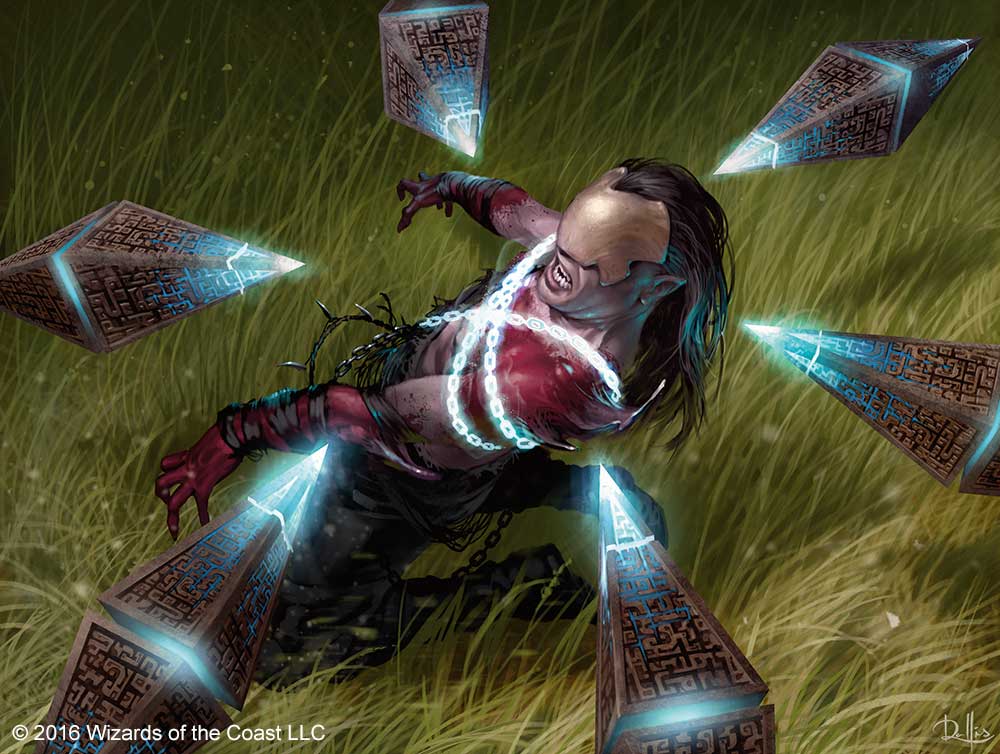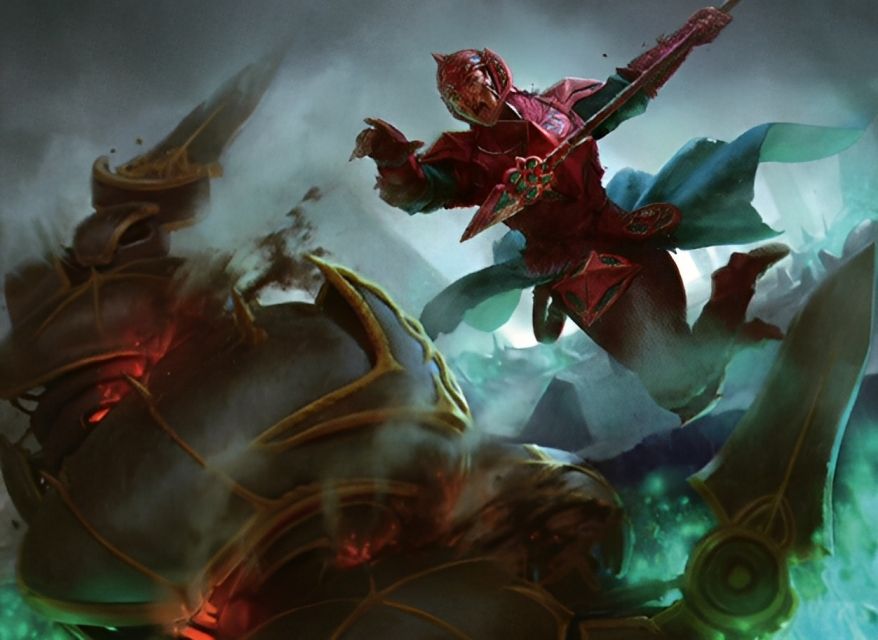
Awakening Zone | Illustration by Johann Bodin
There's nothing quite like being in the zone.
The thing is, there are at least seven different zones in a game of Magic, and often more! Cards are public knowledge in some zones but are hidden information in others; you can arrange your cards in some zones but not in others; some zones are shared….
Fear not, but don't zone out. Let’s go through all the zones in MTG so you know what goes where!
What Are Zones in MTG?

Isolation Zone | Illustration by Chris Rallis
Zones are the places where objects can be during a game of Magic. Objects are Magic's game pieces: things like cards, tokens, spells or abilities on the stack, or an emblem. In other words, zones are all the locations where you can place a game piece during an MTG match.
Each player has their own library, hand, and graveyard zones. In addition, all players share the battlefield, stack, and command zones.
Library
Your library is your deck, from which you draw cards. No player can look at or rearrange the cards of any library unless an effect (like scry or surveil) allows them to.
You can count how many cards remain in any library, though, at any time.
Hand
Your hand is where you hold the cards you've drawn.
You can arrange your hand any way you want, which may sound super obvious but some digital CCGs don't actually allow you to do so (and the card's position in your hand does matter in some of those games). In Magic, it's like in Poker or Bridge: you can sort your hand however you wish.
You can't look at other players' hands unless an effect (like Thoughtseize) allows you to, but you can always count how many cards they have in hand.
Your hand is considered hidden from all other players, even if you've been forced to reveal all your cards. That means that if you have a Choked Estuary and a swamp in hand, you can reveal the swamp as you play Choked Estuary, even if you have previously revealed that swamp. You can even play a second Choked Estuary your next turn and reveal the same swamp again.
Battlefield
The battlefield is Magic's game board. This is where permanents go, and where most of the action takes place in the majority of games.
(Not all games, though; some control decks have a penchant for keeping the battlefield empty and win by other means).
Each player has their own hand and library, but there's a single battlefield that’s shared by all players. Unlike the hand or the library, the battlefield is a public zone. Any player can check any card at any time.
As default, spells or abilities only affect the battlefield unless they specifically mention another zone.
Graveyard
Your graveyard is your discard pile. Permanents that are destroyed or sacrificed end up there; so do instant or sorceries after they resolve, and any spell that’s countered. There are several effects (like Thoughtseize or cycling) that discard a card directly from your hand.
Your graveyard starts out empty, and each card that you discard goes face-up at the top.
Each player has their own graveyard. Cards in a graveyard can’t be rearranged (unless an effect allows you to), and are considered public zones: Any player, at any time, can check the cards in any graveyard.
Stack
The stack is where spells go after being cast and before they resolve. The same happens with activated abilities and triggered abilities.
It's probably the hardest zone to wrap your head around, so I'd recommend further reading.
Like the battlefield, the stack is shared by all players and its information is public.
Exile
Objects in exile are basically kept in hold. Some spells (like Ossification) exile permanents until some condition is met while others (like Swords to Plowshares) exile them permanently.
Like the battlefield, the exile zone is shared by all players and its information is public.
Command
The command zone is reserved for some special objects that affect the game but that aren’t classified as permanents and can’t be destroyed.
The most common examples are commanders in the Commander format, but emblems are also placed in the command zone.
Ante
Some early Magic cards like Darkpact included a “playing for keeps” rule that’s no longer in use and is strictly forbidden under current MTG Tournament Rules. Those cards used the ante zone.
What Are Extra Zones?
Magic has a handful of tongue-in-cheek sets, nicknamed “Un-sets” to highlight their non-competitive and for-fun nature, which use extra zones.
Unstable, for example, has artifacts with the contraption subtype. They go to the scrapyard when destroyed, a special zone reserved for broken contraptions.
Something similar happens with Unfinity and its attractions, which go to the junkyard when leaving the battlefield.
In public zones, all objects are visible to all players. In other words, objects in these zones are public knowledge. Any player can check any object in these zones at any time, unless some effect prevents them.
The battlefield, the exile zone, the command zone, the stack, and all graveyards are public zones. Your hand and library are hidden zones: Only you can examine cards in your hand, and nobody (not even you) can examine cards in your library.
Each player has their own library, hand, and graveyard. All other zones are shared: There's a single battlefield, exile zone, stack, and command zone, and all players share their use.
The order of objects in a library, a graveyard, or the stack can’t be changed unless an effect allows you to. That's why these three zones are said to be ordered.
On the contrary, the order of objects doesn’t matter in your hand or the battlefield, exile, and command zones. Objects in these zones can be arranged however their owners wish, as long as public information is clearly displayed to all players.
(Note that if you play in MTG Arena, the above isn’t entirely true: you can arrange cards in your hand in any order, but the game arranges things on the battlefield, in exile, and in the command zone for you.)
Is the Sideboard a Zone?
Nope.
Cards in your sideboard are considered to be outside the game. “Outside the game” isn’t a zone as per MTG's rules.
Is The Stack a Zone?
Yes, it is!
Is Outside the Game a Zone?
No. Some cards (like Karn, the Great Creator) make reference to cards “outside the game,” but it's not a zone.
Here's the verbatim rule:
400.11. An object is outside the game if it isn’t in any of the game’s zones. Outside the game is not a zone.
When Can You Look At Your Opponents’ Zones?
If it's a public zone (like your opponent's graveyard) you can look at it any time, unless there's some effect preventing you to.
Some effects, like Thief of Sanity or morph, instruct players to put cards face down in certain public zones. Those effects also specify which players, if any, can look at those cards.
If it's a hidden zone like their hand or library, the opposite is true: You can never check cards in those zones unless an effect (like Thoughtseize) allows you to. You can count how many cards an opponent has in a hidden zone, though.
Wrap Up

Kill-Zone Acrobat | Illustration by Justine Cruz
And there you go, those are all the zones in MTG!
I hope I've managed to reveal all the hidden information and clarify how each of them works.
If you have further comments or questions please drop a comment below, stop by the Draftsim Discord for a chat.
And good luck out there!
Follow Draftsim for awesome articles and set updates:

Add Comment